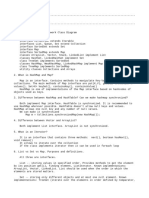0% found this document useful (0 votes)
4 views1 pageJava Interview VSDark Themed Sample
The document provides an overview of Java concepts such as HashMap and encapsulation. It explains how HashMap uses a hash table to store key-value pairs and describes encapsulation as a method to hide internal details of an object while exposing necessary parts through public methods. Real-life examples, such as a school locker system and an ATM, are used to illustrate these concepts.
Uploaded by
JanaCopyright
© © All Rights Reserved
We take content rights seriously. If you suspect this is your content, claim it here.
Available Formats
Download as PDF, TXT or read online on Scribd
0% found this document useful (0 votes)
4 views1 pageJava Interview VSDark Themed Sample
The document provides an overview of Java concepts such as HashMap and encapsulation. It explains how HashMap uses a hash table to store key-value pairs and describes encapsulation as a method to hide internal details of an object while exposing necessary parts through public methods. Real-life examples, such as a school locker system and an ATM, are used to illustrate these concepts.
Uploaded by
JanaCopyright
© © All Rights Reserved
We take content rights seriously. If you suspect this is your content, claim it here.
Available Formats
Download as PDF, TXT or read online on Scribd
/ 1


























































